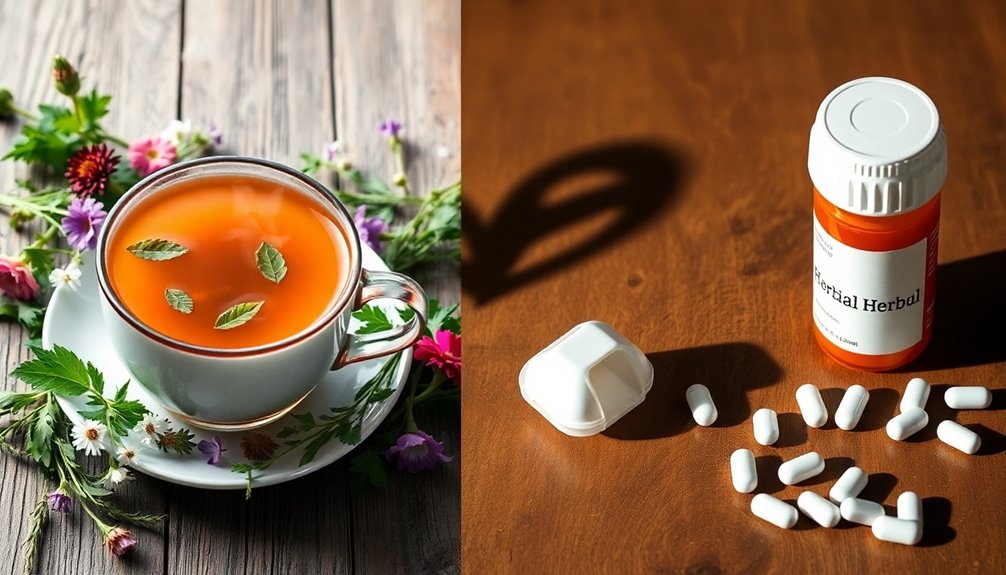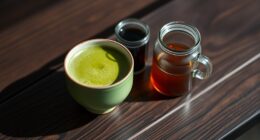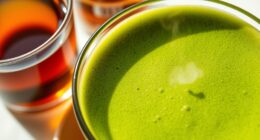If you're looking to lower your blood pressure, certain teas can be super helpful! Try hibiscus tea; it's refreshing and can help drop your systolic pressure by about 7 mmHg! Green tea is another great choice with its yummy taste and heart-friendly catechins. Don't forget about hawthorn berry tea, which improves circulation, or ashwagandha tea, perfect for reducing stress. Herbal teas are also wonderful since they're caffeine-free and gentle on your system. Enjoy these delightful brews, and you'll not only sip something tasty but also lend your heart a helping hand. Keep on exploring and discover even more amazing teas!
Key Takeaways
- Hibiscus Tea: Known for its anthocyanins, it can lower systolic blood pressure by an average of 7.58 mmHg.
- Green Tea: Rich in catechins, it modestly reduces blood pressure by approximately 3 mmHg systolic and 1 mmHg diastolic.
- Hawthorn Berry Tea: Improves circulation and has beneficial effects for blood pressure after consistent consumption over 12 weeks.
- Herbal Teas: Naturally caffeine-free options like chamomile and hibiscus are ideal for managing hypertension.
- Brewing Tips: Brew hibiscus tea with boiling water for 10-15 minutes to maximize its blood pressure-lowering benefits.
Introduction
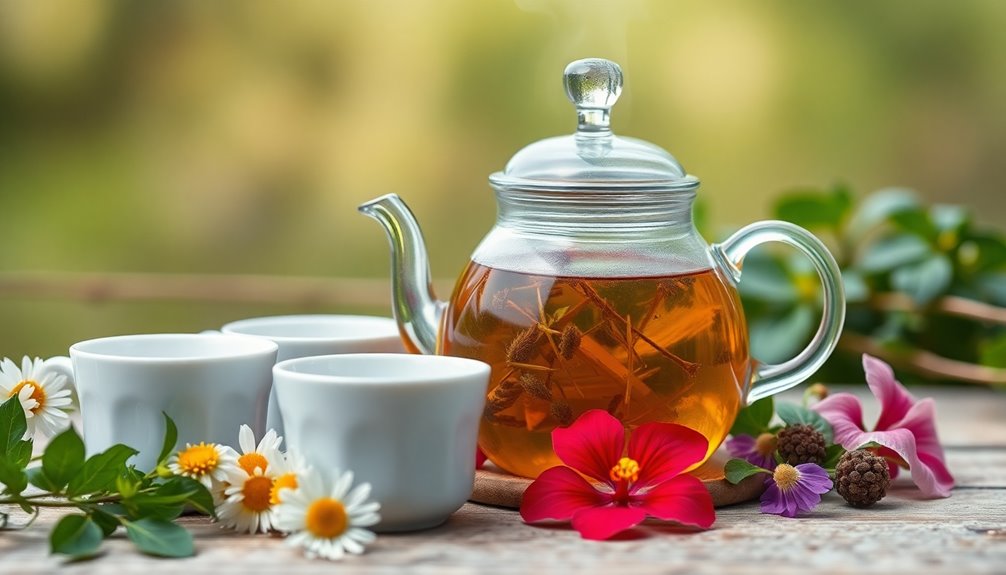
When it comes to managing blood pressure, incorporating certain teas into your daily routine can be a game changer. You might be surprised to learn that hibiscus tea and green tea can help keep your blood pressure in check.
Hibiscus tea contains special compounds called anthocyanins, which work wonders by helping your blood vessels relax. This can lead to lower blood pressure levels, especially for those with mild to moderate hypertension.
Green tea is another fantastic choice! It's packed with catechins, which are known to boost heart health. Studies even show that drinking green tea can lower blood pressure by about 3 mmHg systolic and 1 mmHg diastolic.
Don't forget about herbal teas! Options like hawthorn berry and ashwagandha can improve circulation and reduce stress.
However, it's best to avoid caffeinated teas, as caffeine can temporarily raise your blood pressure. So, stick to delicious herbal and non-caffeinated options to help keep your heart healthy and happy.
Tea's Role in Hypertension Management
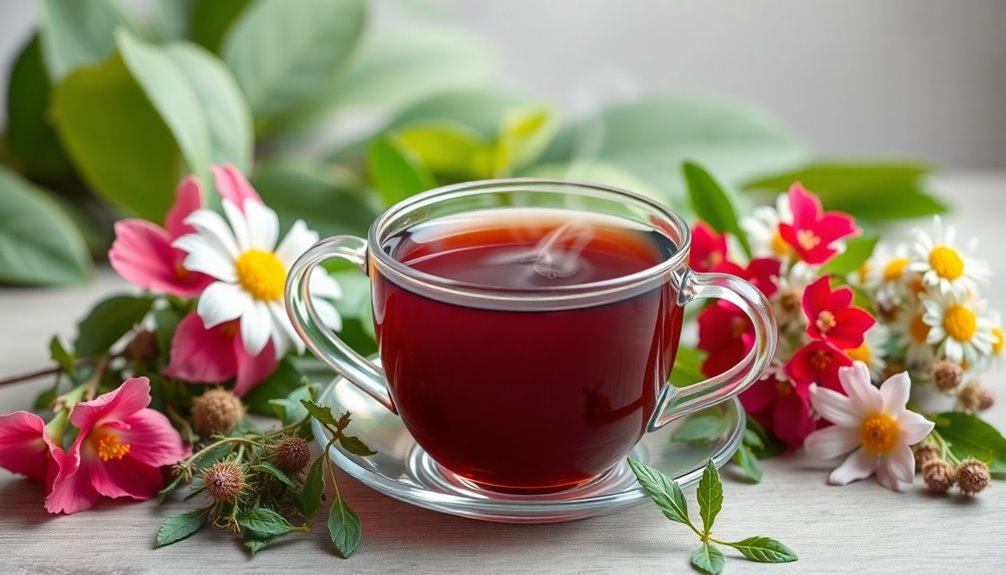
Teas play a crucial role in managing hypertension, offering natural ways to support your heart health. When you sip on hibiscus tea, you're not just enjoying a tasty drink; studies show it can lower your blood pressure significantly! People drinking hibiscus tea have seen their systolic pressure drop by an average of 7.58 mmHg. That's impressive!
Green tea is another great option. It's packed with catechins, which can help reduce blood pressure too. Some studies suggest a modest decrease of about 3 mmHg.
If you're looking for herbal teas, both hawthorn and ashwagandha can work wonders for your heart health as well. Hawthorn, in particular, has shown benefits after just 12 weeks of drinking.
What's even better is the antioxidants, like polyphenols and flavonoids, found in these teas. They help improve blood vessel function and reduce inflammation, making your heart happy!
Just remember, if you're managing hypertension, it's wise to avoid caffeinated teas. Caffeine can raise blood pressure temporarily. Stick with hibiscus and herbal options for a soothing and health-boosting experience!
Tea Polyphenols Reduce Blood Pressure
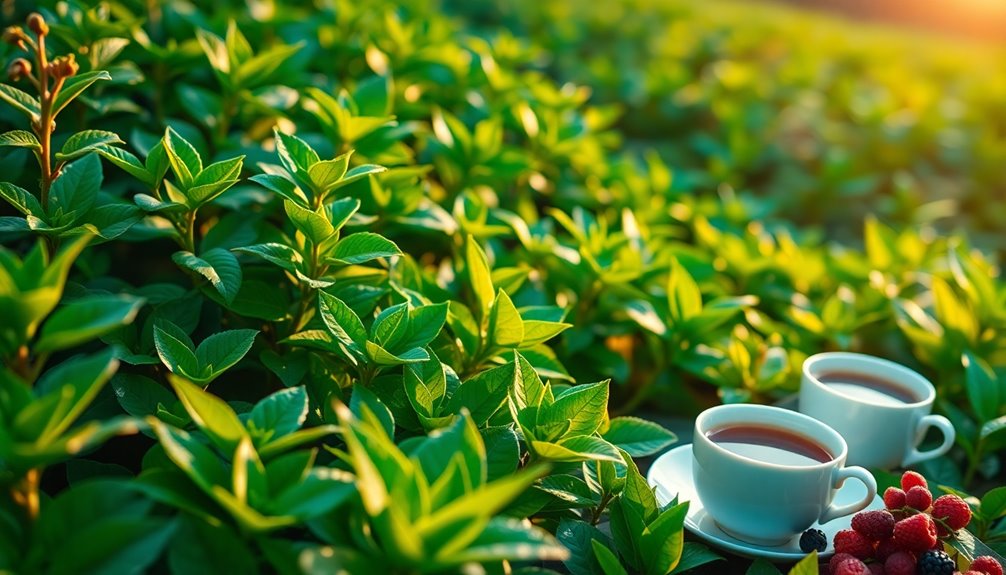
Polyphenols found in tea play a significant role in lowering blood pressure, making them a key factor in hypertension management. When you enjoy a cup of green tea, you're not just savoring a tasty drink; you're also sipping on catechins that help your blood vessels relax. This amazing process is called vasodilation, which can lower your systolic and diastolic blood pressure.
Studies show that regular green tea drinkers may see their systolic blood pressure drop by about 3 mmHg and diastolic by 1 mmHg!
Hibiscus tea is another superstar in the tea world. It's packed with anthocyanins that can lead to significant reductions in blood pressure.
So, if you're looking for ways to support your cardiovascular health, these teas are fantastic choices. They not only taste good but also help reduce your risk of hypertension over time.
You might even consider adding oolong tea to your routine, as its tea polyphenols might also contribute to lowering blood pressure, although more research is needed.
Brewing Temperature Impacts Effectiveness
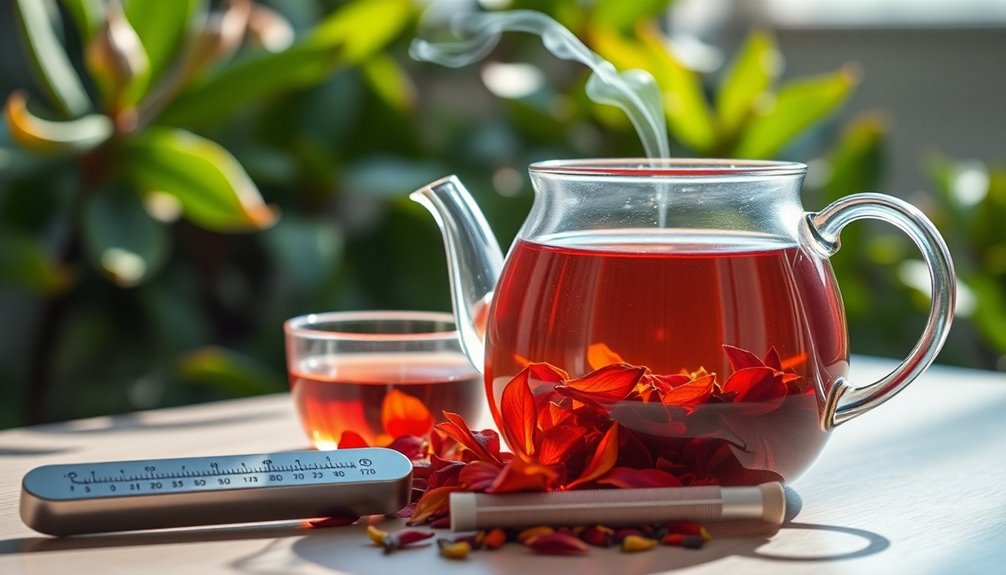
The temperature at which you brew your tea plays a crucial role in how effectively it can lower blood pressure. If you love green tea, remember to brew it at 160-180°F (70-80°C). This helps keep its beneficial compounds, like catechins, intact, which are great for blood pressure reduction!
Now, if you're sipping hibiscus tea, aim for boiling water at 212°F (100°C). This high brewing temperature releases more anthocyanins, which can help lower both systolic and diastolic blood pressure. Isn't that amazing?
For herbal teas, boiling water is also a friend. It extracts active compounds that are helpful for hypertension management.
Don't forget about steeping time! Hibiscus tea should steep for about 10-15 minutes to get the most out of its blood pressure-lowering properties.
But be careful! Overheating green and black teas can damage antioxidants, making them less effective.
Caffeine Content Varies Significantly
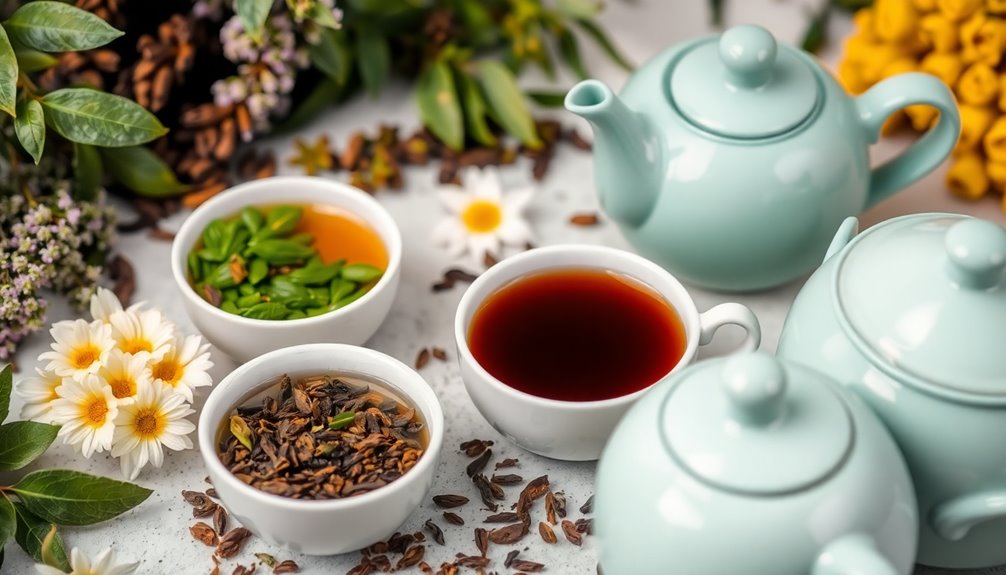
When it comes to managing blood pressure, you'll find that caffeine content in tea can really vary.
For instance, a cup of green tea has about 20-45 mg of caffeine, while black tea can contain around 40-70 mg. If you're watching your caffeine intake, this is super important for blood pressure management! Oolong tea falls in between, with about 30-50 mg of caffeine per cup.
Now, if you prefer something without caffeine, herbal teas are great! Options like hibiscus and chamomile are naturally caffeine-free.
These teas can be especially helpful if you're looking to lower your blood pressure without worrying about caffeine's effects.
Practical Applications
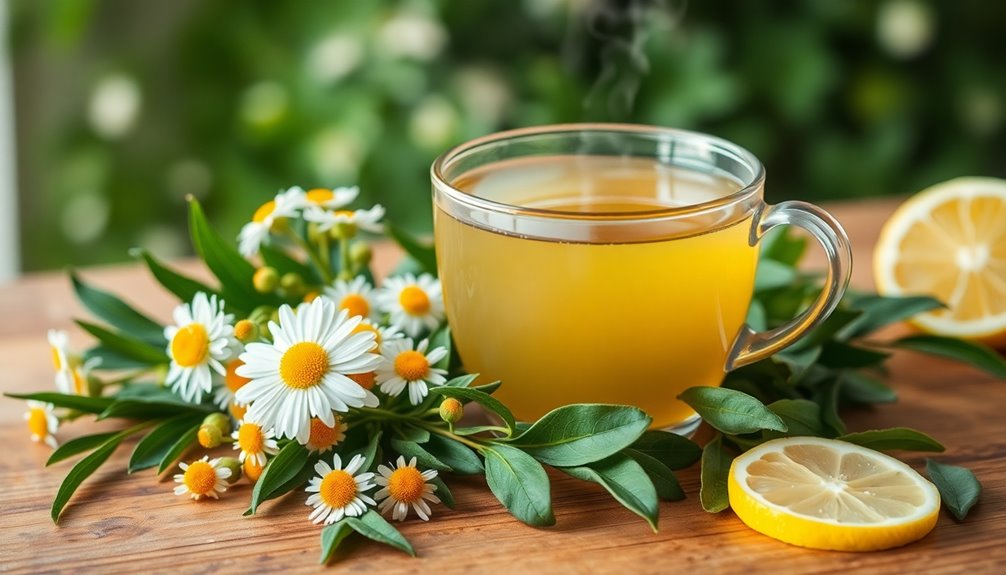
Incorporating specific teas into your daily routine can be a simple yet effective way to help manage blood pressure. One fantastic option is hibiscus tea. Drinking two cups a day can lower your blood pressure by around 7.2 mmHg! That's a great way to tackle hypertension naturally.
Green tea is also a superhero for heart health. Its catechins, especially EGCG, can lower systolic pressure by about 3 mmHg with regular consumption.
You might also want to try hawthorn berry tea. It's known to help lower blood pressure after about 12 weeks. So, sipping on this delicious tea could be a smart choice for your heart health!
Herbal teas like chamomile and ashwagandha can help, too. They're known for their calming effects and can support stress reduction. Less stress means a happier heart!
Frequently Asked Questions
What Is the Best Drink to Lower Blood Pressure?
To lower blood pressure, you might consider drinks like hibiscus tea, beetroot juice, or pomegranate juice. Each offers unique benefits, helping you manage your levels effectively with regular consumption. Stay proactive about your health!
What Tea Should I Drink if I Have Low Blood Pressure?
If you have low blood pressure, consider trying licorice root, ginseng, or ginger tea. Each may help boost your circulation and blood volume, but make sure to consult your healthcare professional before adding them to your routine.
What Herb Lowers Blood Pressure the Fastest?
If you're looking for an herb that lowers blood pressure quickly, ashwagandha's calming properties can help reduce stress-induced hypertension. Consuming it regularly might provide you with faster results than some other herbs. Give it a try!
When Is the Best Time to Drink Hibiscus Tea to Lower Blood Pressure?
You should drink hibiscus tea in the morning on an empty stomach for better absorption. Consuming it two to three times daily, especially in the evening, can significantly boost its calming and blood pressure-lowering effects.
Conclusion
So, if you want to lower your blood pressure, sipping on some delicious tea can be a fun and tasty way to help! Different teas offer special benefits, thanks to their healthy ingredients. Remember to pay attention to how you brew your tea and choose the right kind for you. Enjoying a cozy cup can not only be soothing but also a smart choice for your health. Cheers to happy sipping and feeling great!


